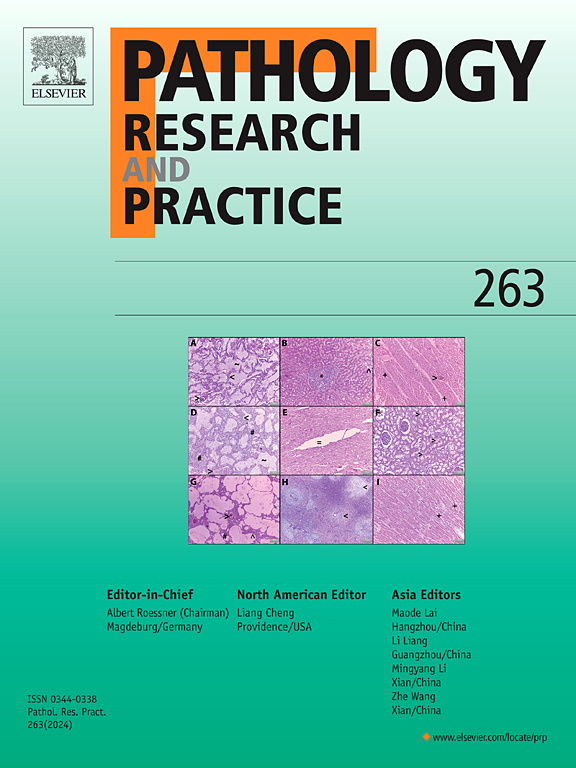肺粘液腺癌中存在与KRAS或GNAS突变相关的显微跳跃生长模式
IF 3.2
4区 医学
Q2 PATHOLOGY
引用次数: 0
摘要
粘液腺癌是非小细胞肺癌(NSCLC)的一种特殊亚型。目前,尚不清楚分子改变是否与临床病理特征相关。方法对93例肺粘液腺癌进行临床评价。进行DNA和RNA测序,并收集临床病理特征。进行相关分析以探讨分子改变、病理特征和临床结果之间的关系。结果KRAS突变频率为49% %。KRAS突变组具有低至中级核分级(p <; 0.001),微观跳跃病变(p = 0.005),血管侵犯患者比例较低(p = 0.030)。TP53突变患者常发生血管侵犯(p = 0.044),中高核分级,特别是高核分级(p = 0.007),肿瘤最大直径大于4 cm (p = 0.012),并与较短的进展时间(TTP)相关。结论本研究发现,KRAS突变的肺黏液腺癌倾向于纯型黏液腺癌,核低至中分级,显微镜下有跳跃病变,无血管浸润。TP53突变的肿瘤往往体积更大,核分级更高,并且经常侵犯血管。这些形态学特征可能提示肿瘤伴有某种分子改变。如果在穿刺活检标本中发现这种情况,可以建议患者进行分子检测,以寻找合适的靶向药物进行治疗。本文章由计算机程序翻译,如有差异,请以英文原文为准。
Presence of microscopic skipping growth pattern correlated with KRAS or GNAS mutations in pulmonary mucinous adenocarcinoma
Introduction
Mucinous adenocarcinoma is a special subtype of non-small cell lung carcinoma (NSCLC). Currently, it remains unclear whether the molecular alterations are associated with its clinicopathological characteristics.
Methods
A total of 93 cases of pulmonary mucinous adenocarcinoma were assessed in this study. DNA and RNA sequencing were performed and clinical pathological characteristics were collected. Correlation analyses were conducted to explore associations between molecular alterations, pathological features, and clinical outcomes.
Results
The KRAS mutation frequency was 49 %. The group with KRAS mutations had low to intermediate nuclear grade (p < 0.001), microscopic skip lesions (p = 0.005), and a lower proportion of patients with vascular invasion (p = 0.030). While vascular invasion (p = 0.044), intermediate to high nuclear grade, especially high nuclear grade (p = 0.007), and tumors with a maximum diameter greater than 4 cm (p = 0.012) were commonly observed in patients with TP53 mutations, which also was correlated with a shorter time to progression (TTP).
Conclusions
In this study, we found that mucinous adenocarcinomas of the lung with KRAS mutations tended to be pure-type mucinous adenocarcinomas with low to intermediate-grade nuclei, microscopic skip lesions, and the absence of vascular invasion. Tumors with TP53 mutations tended to be larger in size and exhibit higher nuclear grade as well as frequent vascular invasion. These morphological features may suggest that the tumor is accompanied by some kind of molecular alteration. If this is found in the puncture biopsy specimen, the patient may be advised to undergo molecular testing with a view to finding a suitable targeted agent for treatment.
求助全文
通过发布文献求助,成功后即可免费获取论文全文。
去求助
来源期刊
CiteScore
5.00
自引率
3.60%
发文量
405
审稿时长
24 days
期刊介绍:
Pathology, Research and Practice provides accessible coverage of the most recent developments across the entire field of pathology: Reviews focus on recent progress in pathology, while Comments look at interesting current problems and at hypotheses for future developments in pathology. Original Papers present novel findings on all aspects of general, anatomic and molecular pathology. Rapid Communications inform readers on preliminary findings that may be relevant for further studies and need to be communicated quickly. Teaching Cases look at new aspects or special diagnostic problems of diseases and at case reports relevant for the pathologist''s practice.

 求助内容:
求助内容: 应助结果提醒方式:
应助结果提醒方式:


